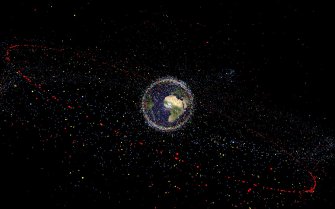Key Takeaways:
- The Kessler Syndrome, proposed by NASA scientist Donald J. Kessler in 1978, warns of a potential chain reaction of exploding space debris that could make space activities and satellite use impossible for generations.
- The danger arises from the millions of micrometeoroids and man-made debris already in orbit, where even small fragments traveling at high speeds pose significant threats.
- A Kessler Syndrome scenario could jeopardize the space program, making travel beyond Low Earth Orbit (LEO) more challenging and putting missions like the planned Mars mission at risk.
- Services reliant on satellites, such as GPS, television, military, and scientific research, would be severely impacted, potentially disrupting core aspects of modern life.
- According to NASA estimates, Earth’s orbit currently contains 500,000 pieces of space debris up to 10cm long, over 21,000 pieces longer than 10cm, and more than 100 million pieces smaller than 1cm.

Exploring the vast expanse of space has been a beacon of hope for humanity, offering opportunities to extend our reach, discover new resources and life forms, and solve earthly problems. However, beneath the veneer of optimism lies a looming threat known as the Kessler Syndrome, a scenario capable of terminating all space exploration endeavors and wreaking havoc on our daily lives.
In 1978, NASA scientist Donald J. Kessler envisioned a catastrophic chain reaction triggered by exploding space debris, rendering space activities and satellite usage unattainable for generations. The premise rested on the proliferation of objects launched into Low Earth Orbit (LEO), creating an increasingly dense environment prone to collisions. Kessler postulated that the debris generated from one collision could escalate the risk of subsequent collisions, eventually overwhelming orbital space.
The crux of this impending danger lies in the existing millions of micrometeoroids and man-made debris orbiting Earth. The threat posed by even minuscule fragments hurtling at high speeds is exemplified by NASA’s calculation that a 1-centimeter “paint fleck” moving at 10km/s can inflict damage equivalent to a 550-pound object traveling at 60 miles per hour on Earth. Multiply this by thousands of such objects colliding, and the potential consequences become alarming.
Should a chain reaction of exploding space junk occur, the entire space program would be in peril. While travel beyond LEO, including missions to Mars, could become more challenging, the gravest impact would be on satellite-dependent services integral to modern life—GPS, television, military operations, and scientific research.

A precursor to the Kessler Syndrome manifested in the 1970s when Delta rockets left in orbit started exploding into shrapnel clouds, prompting Kessler to illustrate the critical mass point where debris in orbit could initiate a self-sustaining collision cascade. NASA experts caution that we may have already reached this critical mass in LEO, situated approximately 560-620 miles from Earth’s surface.
NASA’s estimates paint a grim picture of Earth’s orbit cluttered with 500,000 pieces of space debris up to 10cm long, over 21,000 pieces exceeding 10cm, and a staggering 100 million pieces smaller than 1cm. The 2009 Cosmos-Iridium collision, a space collision between Russian and American communication satellites, showcased the potential consequences, yielding over 2,000 relatively large pieces of space junk.
Despite efforts such as the Space Surveillance Network, overseen by the military, the sheer volume of existing space debris makes the domino effect of explosions a plausible scenario. The timeline, as predicted by Kessler, indicates that it may take 30 to 40 years to reach the critical mass threshold, emphasizing the urgency of addressing this issue before irreversible consequences befall space exploration and modern civilization.
For further insights, one can refer to a video featuring Don Kessler discussing the Kessler Syndrome and Kessler’s original paper titled ‘Collision Frequency of Artificial Satellites: The Creation of a Debris Belt.’ As humanity extends its reach into space, the imperative to mitigate the Kessler Syndrome becomes increasingly vital to safeguard the future of space exploration and preserve the functionality of indispensable satellite services on which modern society relies.


